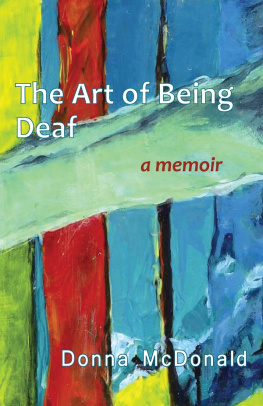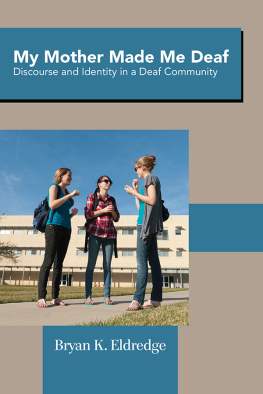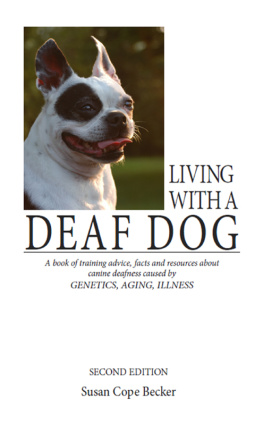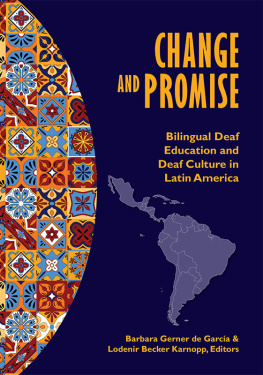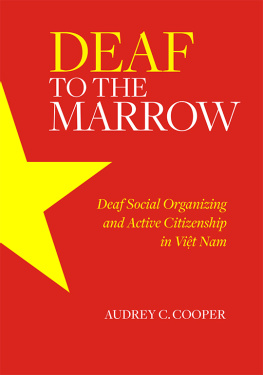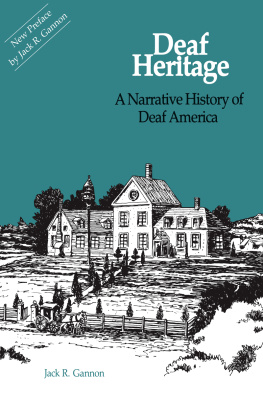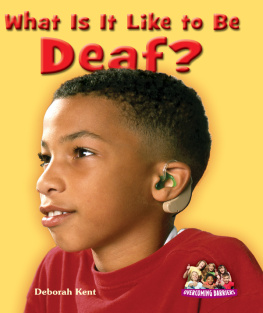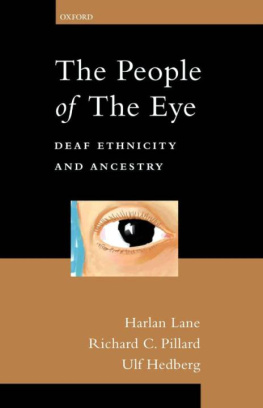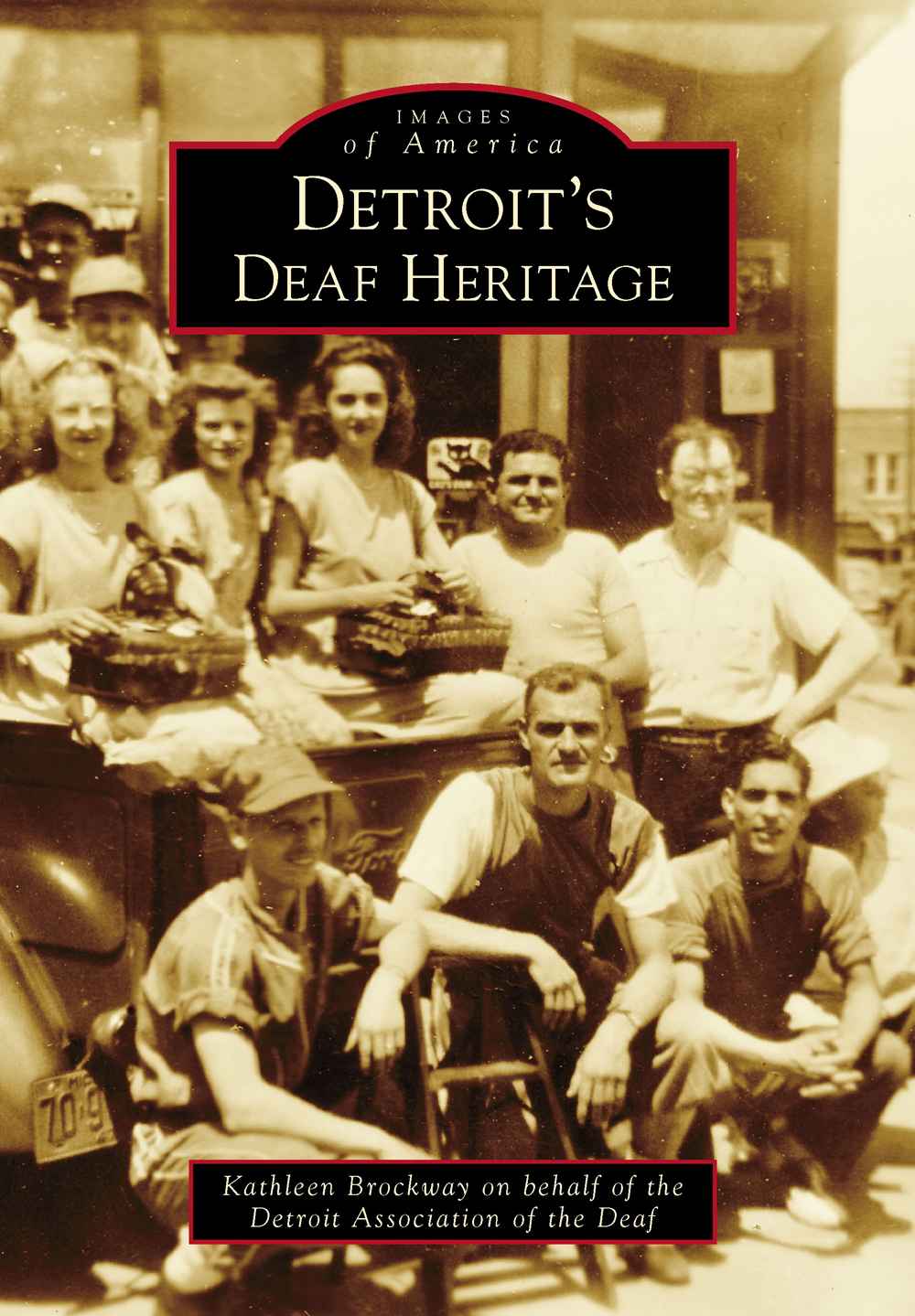
IMAGES
of America
DETROITS
DEAF HERITAGE

ON THE COVER: A group of Detroit Association of the Deaf members and the Wahowiak deaf family are excited to be part of the Fourth of July parade in the Upper Peninsula town of Gladstone around 1945. From left to right are (first row) Frederick McCall, Raymond Wahowiak, Frank Friday Jr., and unidentified; (second row) Germaine Joan Wahowiak, Helen Friday, Melvina Wahowiak McCall, Joseph Nuchs, and John Wahowiak, the Shoe Hospitals deaf owner. Everyone in the third row is unidentified. The Shoe Hospital was located at 901 Minnesota Avenue in Gladstone. John and his wife, Georgianna, ran the shop since the early 1920s. Their deaf son Raymond and his wife, Joan, took over in 1957. The business is no longer running and the structure has been converted into an apartment building. Melvina McCall died in 2015, leaving Helen Friday and Germaine Wahowiak as the only ones in this photograph known to still be alive. (Courtesy of Anson and Kathy McCall Mitchell.)
IMAGES
of America
DETROITS
DEAF HERITAGE
Kathleen Brockway on behalf of the
Detroit Association of the Deaf

Copyright 2016 by Kathleen Brockway on behalf of the Detroit Association of the Deaf
ISBN 978-1-4671-1601-5
Ebook ISBN 9781439656419
Published by Arcadia Publishing
Charleston, South Carolina
Library of Congress Control Number: 2015958047
For all general information, please contact Arcadia Publishing:
Telephone 843-853-2070
Fax 843-853-0044
E-mail
For customer service and orders:
Toll-Free 1-888-313-2665
Visit us on the Internet at www.arcadiapublishing.com
We, Kathleen Brockway and the Detroit Association of the
Deaf, dedicate this book to the Deaf Community.
CONTENTS
ACKNOWLEDGMENTS
As the primary author, I am grateful for everybodys help, including, in no particular order, Patricia Strandell Schultz and David Croll, both DAD members who answered my questions and made referrals with great patience; Ashley and Maureen Aiple, my daughters, for their patience; DAD members who were very great in communicating; Nancy Capek McCall; Clare Cassidy Photography; Ronald Rood Sr. and Rose Russell; Carole Wood Mair; Grace Beaver Wood Cherniaski; the Deaf News group in Michigan; Ray McCall; Arlyn and Hester Meyerson; Judy and Larry Vardon; Glenn and Susan Stewart; Dr. Glenn Anderson; Dr. Ernest Hairston; Istvan Steve Kovacs; Donna Delikta Klarr; Robert and Diane Strandell Snider; Paul and Carol Kuplicki; Paul Kuplicki Jr.; Fr. Michael Depcik and the SJDC volunteers; FAD, MDA, and MSD staff; MSD Alumni Association; Charles and Diane Cutshaw McKittrick; Anson and Kathleen McCall Mitchell; Abram Powell; Diane Knight; Helen Booker; Rosalyn and Jack Gannon; and more whom I have not namedthey have provided wonderful help sharing these stories with the public, especially showing that there are more unknown deaf role models out there.
Key to abbreviations:
| AAAD | American Athletics Association of the Deaf |
| ASL | American Sign Language |
| BSL | British Sign Language |
| CAAD | Central Athletics Association of the Deaf |
| DAD | Detroit Association of the Deaf |
| DDSD | Detroit Day Deaf School |
| FAD | Flint Association of the Deaf |
| LSD | Lutheran School for the Deaf |
| MAD | Michigan Association of the Deaf (later Michigan Deaf Association) |
| MCAD | Motor City Association of the Deaf |
| MDA | Michigan Deaf Association |
| MSD | Michigan School for the Deaf |
| SJDC | St. Johns Deaf Center |
INTRODUCTION
In the early 1900s, Detroit, known as the Motor City, welcomed many, including prominent transplanted figures, to work and interact in the Deaf Community. Detroit attracted Benjamin Beaver along with his brother, Ralph Beaver, both of whom moved from Illinois to the booming city and became active in the newly founded Detroit Association of the Deaf (DAD), one of the oldest deaf clubs in America. They were not the only ones who came from Illinois; Ivor Friday and Henry Furman followed Ralph and Benjamin. The Illinois deaf men joined Emanuel Jacobs, the early Detroit deaf leader, to establish the Rosedale Club at Benjamin and Ralph Beavers home on Rosedale Court in Detroit around 1916. Soon their home became a known social site for the deaf athletes who longed for a permanent club. The main purpose of any deaf club is to be a gathering place in which deaf people can feel free to mingle and enjoy the company of their own kind. Emanuel Jacobs and Ivor Friday soon moved the Rosedalers to Monroe Avenue. According to the 1941 Silver Jubilee Program and Year Book celebrating the 25th-anniversary banquet, everybody agreed that Emanuel Jacobs was the founder and first president of the club. Jacobs was also often the one who took responsibility for completing the details. Friday was known to deserve half of the credit for the establishment. Benjamin Beaver was also honored for the many things he did to push the club into a long-running establishment. He was a longtime member and the oldest at the time of his death.
The Beaver family today runs to five deaf generations on Ralph Beavers side. The Beavers use American Sign Language (ASL) as their primary communication method. Some attended college and had good jobs to support their families and themselves. Tragically, one member of the Beaver family, Carroll C. Wood, was killed in a terrible car collision crossing a Toledo bridge during extremely icy weather on the way to an invitational basketball tournament in Pittsburgh in 1962. Carroll was killed instantly along with fellow Motor City Association of the Deaf (MCAD) basketball players William W. Knight III and Marvin R. Pierce and coach Valerio DiFalco. Carroll was the son of Grace Beaver Cherniawski, and was Ralph Beavers grandson. After graduating from the Michigan School for the Deaf (MSD), Carrolls twin deaf sister, Carole, left to attend Gallaudet College (now University) while Carroll stayed behind and chose to work a stable job as the linotype machine operator for the Wayne Dispatch in Wayne, Michigan.
Not many in the Deaf Community participated in religion; those who did were mostly Catholic or Lutheran. There is a long history of Catholic deaf organizations being active in services to help the Deaf Community. The only known Protestant school for deaf children in America was the Lutheran School for the Deaf. Some students remembered leaving either Detroit Day Deaf School (DDSD) or MSD to attend two years at Lutheran School for the Deaf (LSD) for their confirmation studies, after which some returned to their own schools to remain as students. There were Jewish deaf residents here; some did not practice the Jewish faith in the Deaf Community, despite the fact that one of the first deaf rabbis in America, David Rabinowitz, lived in Michigan. Rabinowitz, a native of New York City, was ordained in 1962 and died in 2007, when his widow moved back to New York. In my interviews, not many knew about him or attended the Jewish services he provided, and no one could find a photograph of him in time for this book.
Sports were my favorite subject of all in researching this book, though I could not share all of the stories here. The most popular sport in the adult Deaf Community in Michigan has long been bowling. There was even a short-lived newsletter, the
Next page

